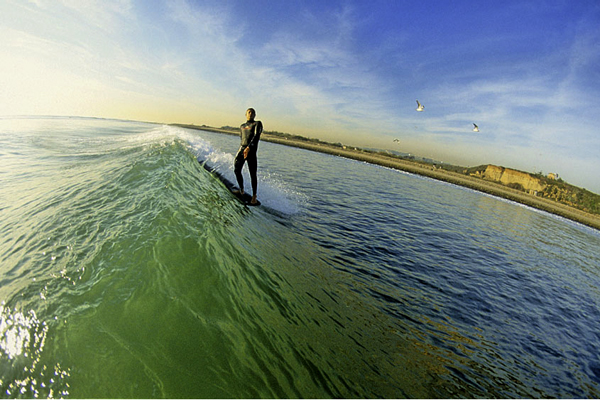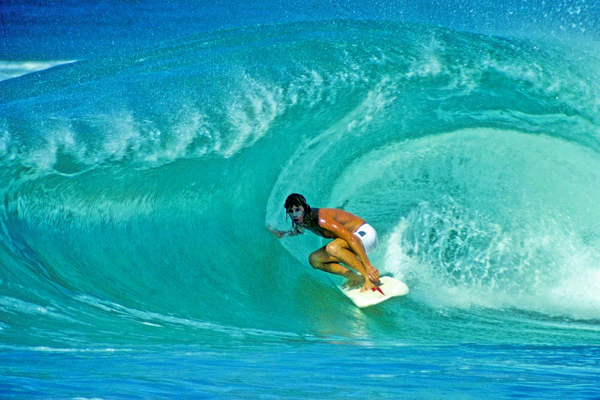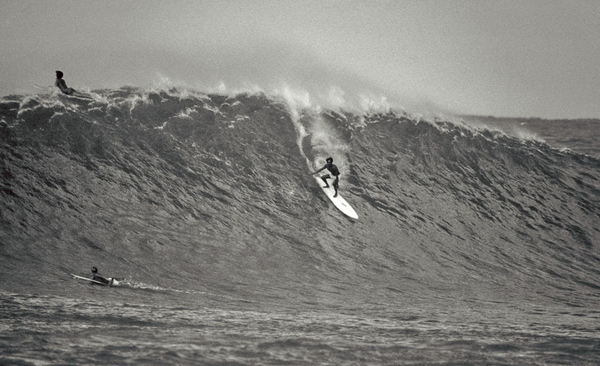Jeff Divine
Interview by Glenn Sakamoto





Jeff Divine is described as one of the best surf photographers in surfing. His keen eye brought us back glimpses of The North Shore and recorded the bold and exciting surfers that defined the ‘70s. We spoke with Jeff to learn more.
What was it like growing up in California?
It was paradise. No freeways – just empty lots for forts and baseball throughout La Jolla Shores. The Marines from Camp Matthews, where UCSD is now, would march down the unpaved La Jolla Shores Drive. All of the neighbors were Korean War and WWII vets. Barry Goldwater would stop by the neighbors’ house for martinis. And Dr. Seuss and Jonas Salk lived up on the hill, while Gregory Peck went to La Jolla High with my Dad. Highway 101 is the only glimpse you can see that’s left of the 50’s nowadays…
When did you get your first surfboard?
1964. I was fourteen and got a rough pop-out from my Hawaiian friend from Pt. Loma, Kame Richards. We were all very ocean-oriented; I grew up two blocks from the beach. We were already getting barreled on rafts and styrofoam boards for years before that. By age 18, we were really deep into surfing. We made boards in my parents’ garage on Hidden Valley Road until the fire marshal shut us down. Then we made more in my grandmother’s garage on Torrey Pines Road. Because of all the activity, the cops thought we had a drug lab going on!
What was the feeling you had when you first stood on a surfboard?
Growing up at a beach break, we would paddle out, turn around and catch the whitewater. We did that for days and days, months before we paddled outside and caught a wave. It was a long transition/evolution of building up skills first. It’s not like there was that big moment of first standing up. We were a group of neighborhood boys who charged everything. If you couldn’t keep up or participate, you were onsidered a dork. Tim Newburn, George Newburn, Bill Matzinger and Jay Matzinger were my neighbors.
Who did you look up to and admire when you were a young man?
My father, George Divine, was an architect and tennis champion. My grandmother, Alice Clark, was an artist and famous begonia grower and had 300 varieties of plants in her garden in La Jolla. I was exposed to a lot of great people growing up.
Early on in my surfing world (1960’s) and later, just based on surfing skills, at that age nothing else mattered. La Jolla, PB, Pt. Loma and North County had many great surfers to look up to. Dicky Moon, Bill Sunkel, Jon Close, Carlos Andrade, Frye, Hynson, Gary Cooke, Fleet White, Tom Ortner, Chris Prowse, Rullo, Randy Pidd, Neal Norris, Kurt Ledterman, the Neilson brothers, Yanon Volcani, Charlie Carter, Pink Bod brothers, Mike Doyle, Eric Hauser, Mike Smith, Guy Hansen, Tom McMeekan, Greg Durbin, Andy Townesend and Matty Welsh. They were all admirably ripping, laughing and cavorting on many different levels.
In the 70’s, we were deep into it with G&S—Larry Gordon ramping up, giving a lot of my friends experimental boards. The Evolution, Witzig film, really rocked our world. Wayne Lynch was our hero. Reed and Joel Mayne, Gary Keating, Tim Lynch, Bob Bowden, Gary Goodrum, Steve Seebold, Blayne Broderson, John Lowrey, Dick Lowell, Xavier, Rusty, McCullom, Ken Mitsuda, Gerald Saunders, Bill Satcher, Jesse Cleveland, Hennesy, Tinkler, Pat Ohern, Kyle and Lee Bakken, Steve Lis, Mark, Rex and Bird Huffman, Jeff Ching, J Riddle, The Hulk, Greg Loehr, Jeff Crawford, Balzerak, Mike Croteau, Debbie Beacham, Jon Foster, Ron Mcleod, Matt Moore, Gary MacNabb, Glomb, Hollingsworth brothers, Greg Mungall , and the Orloff brothers. Because of surfing and my photography, I knew a lot of people from all up and down the coast.
I could go on, but by 1971, I had moved to the North Shore of Oahu and was introduced to a whole different level of really epic surf and surfers.
What inspired you to begin shooting images?
Neal Norris and Tex Wilson (Kauai) were taking photos in the early 60’s in La Jolla. I distinctly remember Neal showing us 8 by 10 prints of David Nuuhiwa surfing at a contest in P.B., Barry Kaniaupuni at Windansea and others. I worked at John Cole Bookstore and immediately went and bought a Pentax with a 400mm Lentar lens from Bob Davis Camera. The rush was to shoot your friends on the best days, process and make prints. I got hooked fast. The Shores, Blacks and Windansea were some of my first shoots. In 1966, I shot my first roll at The Shores where Dicky Moon was out with an Ekstrom fin stabilizer and Doyle was tip riding. Just sat on the wall just north of the bathrooms. Once I had camera in hand, getting a shot in Surfer inspired me as did Ron Stoner’s work.
What do you look for in a good photograph?
That’s a broad topic. I look for some kind of thought behind it all. Technical application, different angle, and something that in some way captures a bit of the emotion of surfing in the sense that all surfers would be attracted to it. There is always one photo that if you laid it out in a group of 20 on a table, most surfers would agree that one is the best. What’s interesting is what a real core surfer would pick has not much to do with technical qualities; it’s all about the moment and surrounding environment of the wave and where is the surfer on the wave. Offshore, sideshore, Santa Ana lighting, tropical blue, slate grey glassy, crystal clear, dark blue, heavy, slab, late, casual, barelled, through the trees, perfect three foot, perfect six feet, perfect ten feet, clean 20 foot are all qualities the layman would never understand.
What advice would you give to an aspiring photographer?
In surf photography, you should be in love with it. It’s not a way to make a living.
Of all the places you have traveled to, what place in particular stands out and why?
South Africa for its variety of climates (from Durban tropical to Capetown cold) and its African culture, beauty, cheapness and epic surf. For pure surfing, the Mentawai Islands off Sumatra. For perfect lefts—I’m a goofy foot—Nemberalla on Timor.
Who/what inspires you?
The LA Times, New York Times, PBS, my wife Julie, my son Taylor, my body of work and all of the different ways to present it to the public. California seasonal changes.
What is the greatest thing you have learned in your life?
Everything works out. It’s not what happens, but how you handle it. You can think of where and what you want to be and then steer towards that and make it.
Do you have any regrets or wish you had done something differently?
That I had used sunscreen (skin cancers) and drunk more water (kidney stones) in this desert climate.
What are you most proud of?
The whole nut: my family, work, house, skills, friends.
What meaning does surfing hold for you and how has it changed your life?
Before I started to surf, between 10 to 13 years old, I’d go to my Granny’s house and slump down in her library and watch TV after school. Surfing got me off the couch and into a whole different universe.
Who are some of the people you feel are shaping the path for surfing today?
The 20 year olds who are pushing the envelope on athleticism in riding waves from two to 20 feet. There’s a lot of them out there. Also the surfers who see the world more and delve into the skills and politics of it all rather than going through life with blinders pointed at the surf.
What is in your current quiver?
I have two Rusty Desert Isle boards I love, a Matt Moore and a Christian Beamish design that I haven’t tried yet.
What’s your favorite meal?
My wife, Julie, is a gourmet cook. Every night is like a fancy restaurant.
What are you currently listening to on your iPod?
I love all music. I have speakers throughout my house and lately have been listening to a lot of light classical. I’m slowly starting to move a bit away from rock. it seems really simple. Classical takes you more on a mind trip of feelings. I listen to rock on Pandora at work.
What are you most grateful for?
That I have a job, I work hard at it and make it. Many in our surf industry have been laid off and are struggling. It’s a bummer. All of the glassers, shapers, ding repairers, glossers, rub out,surf writers, surf photographers, soul surfers, judges, surf shop sales people, etc. have no safety net. Many are contract labor. SIMA should create group health and retirement plans for all surf industry workers. There is a lot more to our surf world, especially in a core surfer sense, than who had a great party and won the ad campaign of the year award. Not to be too cynical of the industry, because the reality is that thousands of surfers have jobs with the sport they love. That didn’t exist in the 60’s, 70’s and into the 80’s.
To view more of Jeff Divine’s work, please visit here. To purchase his book Surfing Photographs from the Seventies, click here. Jeff’s fine are prints are available for sale at the M+B Gallery.
